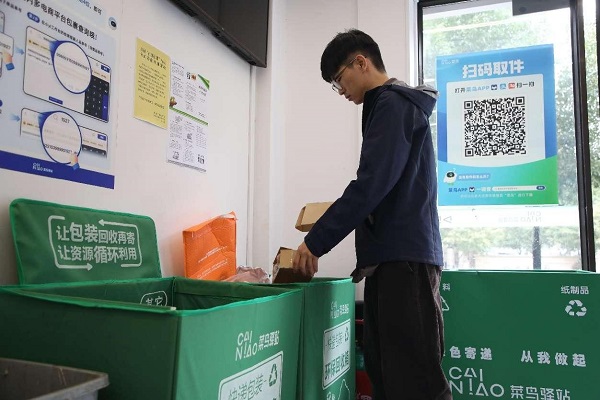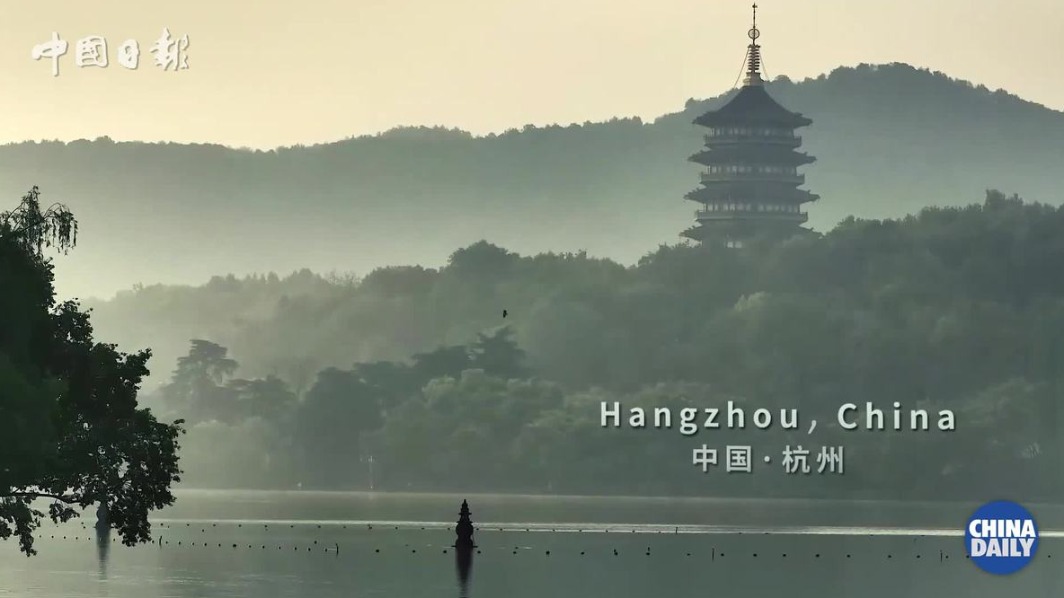a glimpse into express packaging box's carbon reduction journey in china
in recent years, china has constantly promoted the minimization, standardization and recycling of express packaging, continuously reducing energy consumption while boosting the green development of its express delivery sector.
china's express delivery sector has maintained rapid growth over the past decades. during the annual "double 11" online shopping spree (from nov. 1 to nov. 16), express delivery enterprises across the country collected a total of about 7.77 billion packages, surging 25.7 percent from a year earlier, according to the state post bureau.
how can such a burgeoning industry accelerate its transition to green logistics services? a whole-process tracking of the warehousing, packaging, delivery and recycling of an express packaging box by people's daily may offer a glimpse into the efforts.
at 11:15 a.m. on nov. 5, a woman surnamed wang who lives in dongxihu district, wuhan, capital of central china's hubei province, placed and confirmed an order for some products on an e-commerce platform.
nearly at the same time, an order with a serial number ending with 7205 was officially created 50 kilometers away in the largest logistics park in central china - a smart logistics park of cainiao, the logistics arm of china's e-commerce giant alibaba group, in jiangxia district, wuhan.
after intelligent stacker cranes accurately picked up goods one by one from racks ten stories high in a warehouse, automated guided vehicles standing by steadily transported them along a preset route to a packing platform.
when all the goods, which included laundry detergent, yogurt, and facial masks, were ready, an instruction suggesting a customized packaging solution appeared on the computer screen at the packing platform: use no. 8 box, which is 26 centimeters long, 20 centimeters wide, and 20 centimeters high.
"we used to rely solely on experience for packaging. to avoid changing boxes midway and affecting efficiency, we tended to choose bigger boxes, resulting in waste to some extent," said lin fang, a packer who packed the goods ordered by wang.
the problem has been effectively solved by the intelligent box recommendation system of the logistics park, which can automatically generate a packaging plan encompassing box size, product arrangement and protection measures, according to lin, who added that the system has also greatly improved box space utilization.
while talking to people's daily reporters, lin completed the packaging and skillfully pulled out a tape, and then neatly cross-sealed the cardboard box and affixed a waybill to the package. at 11:30 a.m., the package was officially released from the warehouse.
the adhesive tape used at the warehouse now is much "slimmer" than the one used before, according to yi qing, manager of the warehouse.
"the width of the tape was reduced from 60 millimeters to 48 millimeters, the cross-shaped sealing avoids excessive wrapping, and the adoption of waybills using thermal paper instead of regular paper can further reduce material usage," explained yi.
it is estimated that the above-mentioned measures can reduce carbon dioxide emissions generated during the packaging of each cardboard box by about 65 grams.
after departing from the warehouse, the securely packaged goods went through a 100-meter-long corridor via a conveyor belt and entered an automatic sorting line along with many parcels.
while improving efficiency, automation also results in growing energy consumption, according to tang anxin, an executive in charge of the distribution center of the logistics park.
"our fully automated parcel sorting system can save 70 percent of manpower, but has also become the main electricity consumer of the logistics park," tang said.

a consumer puts used cardboard boxes into a recycling bin at a distribution station of cainiao, the logistics arm of china's e-commerce giant alibaba group, in a residential area in hangzhou, capital of east china's zhejiang province. (photo/zhang jie)
"although our electricity consumption has increased, the electricity is greener," said tang, leading people's daily reporters to the roof of a warehouse to show that nearly two thirds of the rooftops of the logistics park are covered with solar photovoltaic (pv) panels.
"the distributed rooftop solar pv system has a total area of over 50,000 square meters. by directly converting sunlight into electricity, it not only meets the power demand of the distribution center, but can also feed the surplus into power grid," tang said.
since it was put into operation in september 2020, the rooftop pv power system of the logistics park generates about 4.1 million kilowatt-hours (kwh) of electricity annually, which is equivalent to a reduction of 2,500 tonnes a year in carbon dioxide emissions. this means that by using electricity produced by pv power system, handling each package can reduce carbon dioxide emissions by about 40 grams.
at 12:57 p.m., wang's package rolled off the sorting line and was loaded onto a vehicle driven by xiang jun, leaving for a distribution station of cainiao in a residential area in dongxihu district.
the driver told people's daily that he switched to a new energy vehicle for cargo transportation early last year. the vehicle travels an average monthly mileage of 4,500 kilometers, saving 50 percent of the operating cost per kilometer compared to a similar fuel vehicle, xiang said.
new energy logistics trucks shuttling between distribution stations and electric two-wheelers running on streets are facilitating the transition of the express delivery sector toward green transportation.
compared to fuel vehicles, new energy vehicles are estimated to be able to help express delivery service providers reduce carbon dioxide emissions by about 20 percent, equivalent to a reduction of about 70 grams of carbon dioxide emissions per parcel delivery.
at 5:45 p.m., with a crisp doorbell ring, the package with a serial number ending with 7205 was successfully delivered to wang.
instead of discarding the packaging box right away as usual, wang took it to a nearby express distribution station together with several other express packaging boxes for recycling as she took out the garbage downstairs. she received 0.5 yuan ($0.07) as a reward for the eco-friendly choice.
"by sending boxes to the distribution station, i can get rid of waste while participating in a public-benefit endeavor. the recycling serves a double purpose," she said.
since consumers were encouraged to participate in packaging recycling, express distribution stations have seen a greatly increased number of boxes recycled.
according to an industry insider, nearly half of the cardboard boxes recycled at express distribution stations are reused for express delivery, and boxes that cannot be reused anymore are turned into paper pulp and made into exercise books, which are then given to students across the country by public welfare organizations.
it is estimated that recycling a used express cardboard box can result in a reduction of about 37 grams of carbon dioxide emissions on average.
with concerted efforts of various links of express delivery services, from warehouses using electricity generated by pv power system to intelligent system-empowered packaging, transportation by new energy vehicles, and box recycling, an express packaging box finishes its carbon reduction journey as if finishing a "green relay race".
-
'nice' to meet you, hangzhou
may 6, 2024

